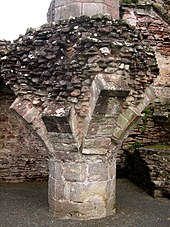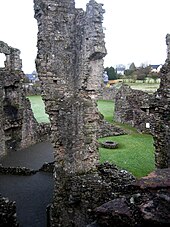This article has multiple issues. Please help improve it or discuss these issues on the talk page. (Learn how and when to remove these messages)
|
| Coity Castle | |
|---|---|
| Castell Coety (Welsh) | |
| Glamorgan, Wales | |
 | |
 | |
| Coordinates | 51°31′19″N 3°33′11″W / 51.521944°N 3.553056°W / 51.521944; -3.553056 |
| Site information | |
| Owner | Cadw |
| Open to the public | Yes |
| Condition | Ruined |
| Website | Castell Coety |
| Site history | |
| Materials | Stone |
Coity Castle (Welsh: Castell Coety) in Glamorgan, Wales, is a Norman castle built by Sir Payn "the Demon" de Turberville (fl. 1126), one of the legendary Twelve Knights of Glamorgan supposed to have conquered Glamorgan under the leadership of Robert FitzHamon (d. 1107), Lord of Gloucester. Now in ruins, it stands in the community of Coity Higher near the town of Bridgend, in the County Borough of Bridgend. Very close to the castle is the battlemented parish Church of St Mary the Virgin, which dates from the 14th century.
The castle is a Grade I listed building.
History
Pre Norman Coity
Most Norman castles in Glamorgan (e.g. Caerphilly, Cardiff, Loughor) occupy sites which had previously been Roman forts and it is likely that the Norman castle at Coity occupied the site of an existing structure. Potential Roman military activity at the site is supported by the strategic importance of the location. A Roman fort would have controlled a number of early routes and Heol Spencer, which appears on the earliest maps of the area, has been proposed as a Roman Road because of its age, importance and remarkable straightness (which today, only deviates around the castle grounds itself).
Despite this archaeological interest, no excavation has been carried out to identify any Roman remains.
First Norman Castle

The castle began as a late 11th-century ringwork. A rectangular stone keep and the main curtain wall were added by the Normans in the 12th century, under the de Turberville family. The three-storey keep was primarily a defensive structure.
Extensive reworking took place in the 14th century, when a domestic range was attached to the keep by the middle gatehouse. New stone vaults replaced the earlier timber floors. The central octagonal pier for the vaults is still prominent among the castle ruins. An adjoining chapel wing with a tall east window was added to the first floor at the eastern end of the domestic range in the 15th century.
15th century

Thomas de la Bere died as a minor on 28 October 1414, following which the lordship reverted to Sarah de Turberville, the youngest sister of Richard de Turberville, who had apparently produced male progeny from her marriage to William Gamage. There was in the few years following Sir Lawrence Berkerolles's death much general reshuffling of property interests in Glamorgan, for example with the Stradling family. Sarah's marriage to Sir William Gamage of Roggiett, Gwent, brought the lordship into the Gamage family, where it remained until 1584. The Gamage succession was not, however, easily achieved for in September 1412, that is to say whilst the supposed true heir the minor Thomas de la Bere was still alive, William Gamage assisted by Sir Gilbert Denys (d. 1422) of Siston, Gloucestershire, and formerly of Waterton-by-Ewenny, in Coity lordship, besieged Coity for a month, trying to oust Lady Joan Verney, wife of Sir Richard Verney and daughter of Margaret de Turberville, from the Castle. Joan, it seems, had taken up residence to assert her own claim to Coity in the confusion following Berkerolles's death. As she was a female, a widow, and without a son, clearly her claim was deemed tenuous or rather completely spurious. The entry in the Patent Rolls is:
Westminster Sept. 16, 1412. Commission to William Newport, Chivaler, Rees ap Thomas, John Organ, William Sparenore, Richard Delabere and Robert Wytney on information that Gilbert Denys, Chivaler, and William Gamedge, with no moderate multitude of armed men have gone to the castle of Coytif in Wales and besiege it and purpose to expel Joan, late the wife of Richard Vernon, Chivaler, from her possession of it, to go as quietly as they can to the castle and raise the siege, cause proclamation to be made that no one under pain of forfeiture shall besiege it, but those who pretend right and title in it shall sue according to law and custom. Arrest and imprison all who oppose them and certify thereon to the King in Chancery. By K.
The king had, therefore, given a commission to his local tenants-in-chief to raise the siege and gave another commission a month later to John Grendour for the same purpose. Denys and Gamage ended up in the Tower of London for having taken the law into their own hands, from 19 November 1412 until 3 June 1413, being released after the death of Henry IV. Their action, however, proved successful in enforcing the Gamage claim to Coity. Denys's eldest daughter Joan was the wife of a certain Thomas Gamage, possibly brother of William. Another of Denys's daughters, Matilda, by his 2nd. wife, married another Thomas Gamage, son or grandson of William and Sarah, and thereby became Lady of Coity on her husband's succession, producing a son and heir John Gamage.
Tudor Period
During the 16th century, Coity Castle, by then owned by the Gamage family, underwent a complete remodelling of the living quarters, including the addition of a storey, new windows, and two chimney stacks. The principal chambers lay on the upper floors. The range of domestic apartments comprised a central first-floor hall set above a vaulted undercroft, from which it was reached by a grand spiral stair. To the west were ground-floor service rooms, probably including a kitchen, with ovens. The base of a ruined large malting kiln remains. On the far side of the range, a tower projecting from the curtain wall contained latrines. The second floor housed private apartments.
The Gamage family held Coity until the death of John Gamage in 1584.
Later history
The castle was abandoned around the 17th century. The castle was sold in the 18th century to the Edwins of Llanharry. Through the Edwins, the Coity lordship passed to the Earls of Dunraven.
The castle ruins are now in the care of Cadw.
Castle Occupants
It was originally built and inhabited by Payn de Turbeville and his wife, the daughter of Morgan ap Meurig, in 1092. In 1180, Sir Gilbert de Turberville, Lord of Coity, took over the castle and carried out extensive renovations. The Turberville family retained ownership of the castle until the 1400s. Sir Lawrence Berkerolles occupied the castle in the late 1300s, followed by Lady Joan Verney, a childless widow, in 1411. William Gamage, husband of the youngest Turberville sister, took over the castle in 1413. In 1584, the castle was home to Barbara Gamage and Sir Robert Sydney, Earl of Gloucester.
Visiting the Castle
Located on Plas Road in Coity village, about three miles from Bridgend. Visitors can access the ruins by taking the A4061 road and following the well-placed signposts. The nearest postcode is CF35 6BG. The castle is open year-round, and visitors are welcome to explore the ruins at any reasonable time during daylight hours.
A small parking area is available beside the main gatehouse on the west side of the ruins, although it is not clearly marked. However, visitors can inspect the southern castle walls from the main road. To access the eastern walls, visitors can take a short path down Heol yr Eglys, a side road. This path leads to a field where the exterior of the northern walls can be viewed.
Architecture
Coity Castle's inner ward is a circular area of approximately 150 feet (46 metres) in diameter. The area is protected by walls that stand up to 30 feet (9.1 metres) tall to this day. Surrounding the inner ward is a sub-circular ditched enclosure measuring 36–42 metres (118–138 ft) in diameter. Adjacent to the enclosure lies a sub-rectangular enclosure measuring 55 metres (180 feet) in an east–west direction and 36 metres (118 feet) in a north–south direction. The castle's ruined curtain walls on the western side enclose several remains of the internal buildings.
Locomotive
Great Western Railway Castle Class steam locomotive number 5035 was named Coity Castle.
See also
- List of castles in Wales
- List of Scheduled Monuments in Bridgend
- List of Cadw properties
- Castles in Great Britain and Ireland
References
- "Coity Castle, Coity Higher". British Listed Buildings. Retrieved 18 July 2015.
- Cadw. "Coity Castle (11254)". National Historic Assets of Wales. Retrieved 1 May 2019.
- Sherman, Evans, Andy, Edith (2004). "Roman roads in Southeast Wales Desk-based assessment with recommendations for fieldwork September 2004" (PDF). Glamorgan and Gwent Archaeological Trust. 75 (2004/073): 61.
{{cite journal}}: CS1 maint: multiple names: authors list (link) - Evans, EM (2002). "Coity Link Road, Bridgend, archaeological desk-based assessment". Glamorgan and Gwent Archaeological Trust. 2002/063.
- Cadw informational sign posted at Coity Castle
- Denys was probably the son of John Denys of Waterton mentioned in Clark's Cartae no. MXLIII, 1376, who was granted a lease by Margam Abbey. Sir Gilbert Denys is mentioned as renting property at Waterton from Sir Roger Berkerolles in the latter's Inq.p.m.
- Patent Rolls, 12 Oct 1412, at Westminster.
- Roskell, J.S. History of Parliament: House of Commons 1386–1421 (vol.2) 1992, p772. Biog. of Sir Gilbert Denys.
- See the will of Sir Gilbert Denys in which he names his da. Joan "wife of Thomas Gamage" as his executrix. Line 12: "Ordino et confirmo Johnam filiam meam uxorem Thom. Gamage..."National Archives, PROB 11/2B Image Ref:413/285.
- Dictionary of Welsh Biography, National Library of Wales. Welsh Biography Online. (Gamage)
- Cadw informational sign posted at Coity Castle
- ^ Griffiths, Royston; William John Morgan; Vaughan Richards (2007). A History of the Parish Church of St. Mary the Virgin. Parish Church of St. Mary the Virgin, Coity.
- ^ may, mark. "Coity Castle". crazyaboutcastles. Retrieved 3 May 2023.
- may, mark. "Mr". cadw.org.wales. cadw. Retrieved 3 May 2023.
- "'Castle' class details, 5000 – 5049". The Great Western Archive. Retrieved 1 May 2019.
Sources
- The Welsh Academy Encyclopaedia of Wales. John Davies, Nigel Jenkins, Menna Baines and Peredur Lynch (2008) pg160 ISBN 978-0-7083-1953-6
External links
- Cadw: Coity Castle
- Coity Castle at Wales.red website (includes many panoramic photos and other photos)
